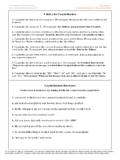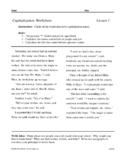Transcription of CAPITALIZATION OF TENANT IMPROVEMENTS
1 Revised July 2001 CAPITALIZATION OF TENANT IMPROVEMENTS2 CAPITALIZATION of TENANT What is a TENANT improvement (TI)?.. CAPITALIZATION Guidelines .. Approval Levels .. Budgeting for TIs .. Related Amortization .. 5 Appendix A: Examples of TENANT 6 Appendix B: Accounting 7 Appendix C: Commonly Asked Questions and Answers .. 8 Appendix D: Glossary of Terms .. is a TENANT improvement (TI)?A TENANT improvement (TI) is any construction requested by tenants toaccommodate their particular work function or aesthetic needs over and abovethat which is provided within the base building envelope. Refer to Appendix A forexamples of TIs. These IMPROVEMENTS must be made to "leased" buildings, notbuildings owned by the TI does not include the following: temporary or portable partitions/screens ( , systems furniture),cubicle dividers, etc.
2 (these are considered to be office furniture) pre-feasibility studies (includes review of project options) and feasibilitystudies ( , preparation of the project brief and any project planning) lease negotiation/renewal fees costs of moving staff into new space salary costs of ministry staff betterments (structural IMPROVEMENTS to the building) re-arrangement of office Guidelines Only TIs to leased buildings may be capitalized. Qualifying IMPROVEMENTS toministry owned buildings would be capitalized as a betterment to the refer to Core Policy and Procedures Manual (CPPM)Chapter TIs with a project cost greater than $50,0001 and a useful life greater thanone year shall be capitalized. External contributions of less than $50,000 towards the project cost of a TIare effectively netted against the gross acquisition cost, but two STOBs mustbe used (refer to CPPM ).
3 If the gross acquisition cost of the assetexceeds the required TI CAPITALIZATION threshold of $50,000, the gross cost ofthe asset must be set up and amortized over the lesser of the life of the leaseterm or 5 years. The contribution must be set up as a deferred revenue andamortized over the same period. TIs with a project cost of less than $50,000 shall be expensed. The useful life of a TI has been set at the lesser of five years or the For CAPITALIZATION purposes, TIs do not include: embedded TIs special TENANT IMPROVEMENTS (formerly known as special featurepremiums) mandatory operating equipment, as defined by British ColumbiaBuildings Corporation (BCBC) mandatory and discretionary institutional projects (recovered as anadjustment to base rent versus an amortized TENANT improvement (limited to items such as lock-downs in jails.))
4 Costs associated with land/sites planning costs for cancelled TIs (these are required to be paid out). LevelsPlease refer to the Treasury Board approval levels as stated inTreasury Board Directive 5/04.( ) for TIsMinistries are required to budget for the number of TI projects planned for eachfiscal year. TIs with a useful life greater than one year and a project cost inexcess of $50,000 should be included as part of the capital budget. TIs with auseful life of less than one year and/or a project cost less than $50,000 will beexpensed and included in the operating may be used in instances where capitalized TI projects whichare approved for completion in one fiscal year, but are not completed by thefiscal year end due to project delays. Ministries may encounter unanticipatedproject delays near the end of a fiscal year that result in the deferral of TIs intothe following year for which there is no budget.
5 In this case, ministries mustexhaust all internal resources prior to requesting access to capital should routinely inform their Treasury Board Staff analyst of any TIprojects that are significantly delayed or subsequently deferred to another some cases, ministries may incur unanticipated TIs for which there is nobudget. If the TI has a useful life of more than one year and a project cost inexcess of $50,000, the ministry must exhaust all internal resources2 ( , budgetroom within its overall capital budget) before it may request approval, via aTreasury Board Submission, for access to capital contingencies. If the TI has auseful life of less than one year and/or a project cost of less than $50,000, thesame process applies to access to operating contingencies. The ministry is stillrequired to obtain Treasury Board approval for all projects greater than $150, Termination/Voluntary MovesMinistries which voluntarily vacate or cancel a commitment to occupyaccommodation before the end of the agreed upon term will be required torecognize a disposal of any TIs.
6 The resulting loss will be treated as an expensein a ministry s operating budget. This will include any costs to return the buildingto a condition suitable for future MovesForced moves permit BCBC and ministries to force move other , TIs being used by the ministry initiating a move would be transferred atnet book value to the subsequent lessee but this is subject to , if the subsequent lessee does not agree, costs associated with theforced move ( , loss on disposal of TIs) should be expensed by the ministryinitiating the move. Where a TI is transferred at less than net book value, thedonating ministry must immediately record (against its operating budget) the losson disposal generated from the RelocationBCBC is required to strategically manage the accommodation costs acrossgovernment through a series of measures. In the event that BCBC implements arelocation in a strategic initiative ( , accommodation cost reduction), BCBC must compensate the affected ministry for any loss arising on the disposal of AmortizationTIs qualifying for CAPITALIZATION will be amortized over the lesser of five years orthe lease term using the mid-month rule (not pooled).
7 The amortization cost willbecome part of a ministry s operating A: Examples of TENANT ImprovementsTenant IMPROVEMENTS are IMPROVEMENTS performed in a leased building over andabove the provision of basic space requirements. Keeping in mind the $50,000threshold, some examples of normal TENANT IMPROVEMENTS , as described byBCBC, are as follows: Keyed switches to elevators to restrict after hours access and special locationindicators and controllers. All initial wall finishes on TENANT improvement partitions. Floor finishes beyond defined standard requirements in TENANT areas. All fittings and fixtures within the designated rentable areas, such as millworkand TENANT signage counters. Additional work for heating, ventilation, air-conditioning and rebalancingsystems to suit TENANT floor layouts and usage, including re-arrangement ofexisting zones and adding new zones and controls.
8 This includes diffusersand branch duct reallocations and/or alterations. This also includes systemsor equipment required for areas with very high thermal loads or stringentprocess-related environmental criteria as well as special exhaust and airmake-up systems to laboratories or industrial spaces. Upgrade to fire protection systems ( , specialized applications such assystems or laboratory protection) to comply with specialized tenantrequirements. All plumbing for additional refreshment areas and additional washrooms,showers to support job function, and plumbing required for laboratory orspecial areas, other than those required by the building code for operationand maintenance of the building. All electrical power distribution in TENANT s partitions and within TENANT areas,such as service poles, power and controls for all TENANT improvementequipment, and specialized power such as isolated grounds, dedicatedpower, power conditioners and uninterrupted power supplies.
9 Additional lighting and controls to suit TENANT space layout and of light fixtures and diffusers in excess of those provided in basebuilding, as well as specialty lighting such as pot lights, track lighting. Adjustment to the location of EXIT and emergency lights to suit tenantlayouts and exit routes. Office TENANT security, communication, public address and wiring systems,excluding removal and replacement and new mandatory operating equipmentwhich are intrinsic to the building. Data cabling other than defined standard provided in the base B: Accounting Entries2000/01+ After TENANT IMPROVEMENTS Class has been capitalizedAcquisitions of new capitalizable TENANT improvementsDR Asset (full cost of the TI)CR Cash (full cost of the TI)Amortization of the TI asset costDR Amortization ExpenseCR Accumulated AmortizationNote: Refer to CPPM Chapter I for general C: Commonly Asked Questions and Answers1.
10 What is the budgeting and approval process (both for annual budgetsand new projects identified) and how will it be linked to the ministry scapital and operating are required to budget for the number of TI projects planned foreach fiscal year. TIs with a useful life of more than one year and a projectcost in excess of $50,000 should be included as part of the capital with a useful life of less than one year and/or a project cost less than$50,000 will be expensed and included in the operating some cases, ministries may incur unanticipated TIs for which there is nobudget. If the TI has a useful life of more than one year and a project costin excess of $50,000, the ministry must exhaust all internal resourcesbefore it may request approval for access to capital contingencies. If theTI has a useful life of less than one year and/or a project cost of less than$50,000, the same process applies to access to operating Who is responsible for tracking and reporting?







